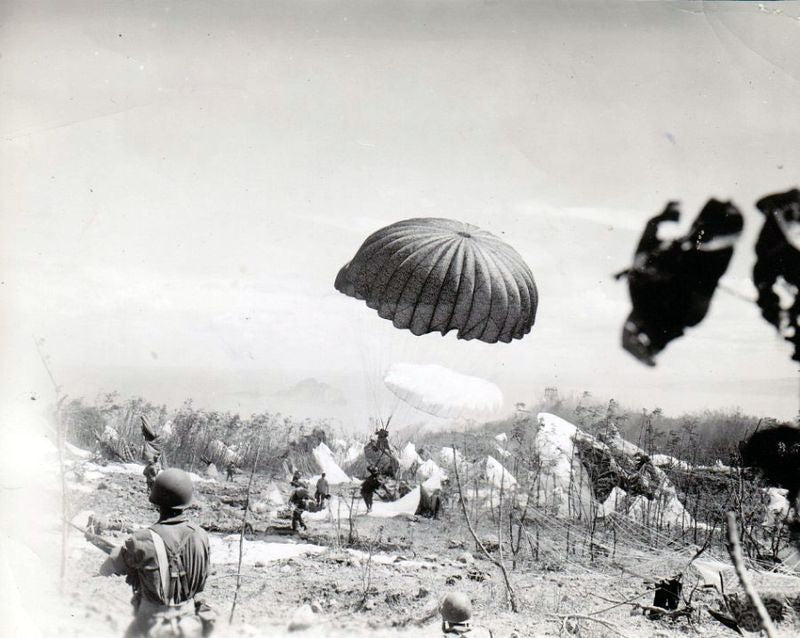
The Battle For Corregidor
This write up is from the The Airborne and Special Operations Museum www.asomf.org
In May 1942, Corregidor, a small rock island at the mouth of Manila Bay, remained one of the last Allied strongholds in the Philippines after the Japanese victory at Bataan. Constant aerial bombardment attacks by the Japanese ate away at the American and Filipino defenders.
The Allied troops could not hold the Japanese off any longer, so General Jonathan Wainwright, commander of the U.S. Armed Forces in the Philippines, offered to surrender Corregidor to Japanese General Masaharu Homma, but Homma wanted the complete, unconditional capitulation of all American forces throughout the Philippines. Wainwright had little choice given the odds against him and the poor physical condition of his troops—he had already lost 800 men. He surrendered on April 9, 1942, and all 11,500 surviving Allied troops were evacuated to a prison stockade in Manila.
RETURN TO CORREGIDOR: FEBRUARY 16, 1945
The Americans returned to the Philippines in full strength in October 1944, beginning with the recapture of Leyte, the Philippines’ central island. Following this victory was the return of General MacArthur and the struggle for Luzon and the race for Manila, the Philippine capital. One week into the Allied battle for Luzon, U.S. airborne troops parachuted onto Corregidor to take out the Japanese garrison there. This mission was called Operation TOPSIDE.
The 503rd Regimental Combat Team (RCT) successfully assaulted Corregidor “The Rock” on February 16, 1945. American forces had entered Manila on February 5, and while they were driving the Japanese out of the city, many enemy troops escaped across the bay to Bataan and Corregidor, scenes of American defeat in 1942. To secure these positions in the U.S., Sixth Army landed a force at Mariveles on the tip of Bataan, opposite Corregidor, on February 15, with a plan to advance and meet another force driving down the east coast of Bataan. The next day, it launched the airborne assault on Corregidor, followed by amphibious reinforcement.
The drop at Corregidor began at 8:30 AM on February 16, 1945. In two lifts, 82 C-47’s of the 54th Troop Carrier Wing carried 2,050 men of the 503rd from Mindoro. The initial drops were made from an altitude of 650 feet, but this was soon reduced to 500 feet or less to minimize drift. The RCT included two battalions of the 503rd Parachute Infantry and its headquarters, engineer and service companies, and field artillery batteries of 75 mm howitzers from the 462nd Parachute Field Artillery.
The troops faced an estimated enemy defense of 850 (later proved to be over 5,000) in heavily fortified positions. The paratroopers completely surprised the defenders and speedily seized their first objective. By the end of February 16, they were firmly established on Topside, while the amphibious force was in control of Malinta Hill, the dominating terrain in the beachhead area. The 3rd battalion of the 34th Infantry, reinforced, had landed at San Jose beach that morning between the two airlifts and secured the hill after suffering heavy casualties from land mines on the beach. With the two successes of the 16th, the assault phase was complete, but many Japanese survivors hid in the Malinta Tunnel for safety.
Ironically, the tunnel, 1,400 feet long and dug deep in the heart of Corregidor, had served as MacArthur’s headquarters and a U.S. supply depot before the American defeat there. MacArthur feared the Japanese soldiers could sit there for months. The garrison had no such intention, though, and ignited a nearby ammunition dump—an act of defiance, and possibly of mass suicide. Most of the Japanese were killed in the explosion, along with 52 Americans. Those Japanese who survived the blast were forced out into the open and decimated by the Americans.
By February 27, the Americans had killed about 4,500 Japanese and captured 19. Corregidor was officially in American hands by early March, but not without loss. The Americans suffered more than 1,000 casualties by March 2, including 210 deaths.
General MacArthur inspected the 503rd on March 2, 1945. After Congratulating the troops on their victory, he said, “I see that the flagpole still stands…. Hoist the colors to its peak and let no enemy ever haul them down.”
Following the successful recapture of Corregidor, the 503rd Regimental Combat Team earned not only the Presidential Unit Citation, but also the nickname, “The Rock Regiment”. While convalescing on Minodoro Island after the battle, Private First Class Thomas McNeill painted this image on his duffel bag using Red cross provided paint. It became so beloved by his fellow Soldiers that it was adopted as the unofficial unit insignia.

1 comment
Awesome story of courageous men!! AATW!